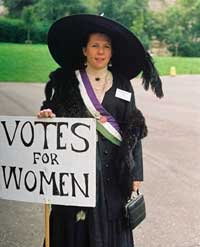The story of Women’s Emancipation - Introduction
 Not really until the 18th Cent did anyone give any thought to anyone else’s rights. In the early 19 th cent a woman was the ward of her husband – the same status afforded to infants and children. This meant her husband could spend her income and property, that she had no right to child custody, care or visitation, and that he retained the right to ‘chastise’ her physically without the need to show cause.
Not really until the 18th Cent did anyone give any thought to anyone else’s rights. In the early 19 th cent a woman was the ward of her husband – the same status afforded to infants and children. This meant her husband could spend her income and property, that she had no right to child custody, care or visitation, and that he retained the right to ‘chastise’ her physically without the need to show cause.
On the other side of the Atlantic matters were a little further forward. After the American war of independence some women (notably Abigail Adams) lobbied for women to be given the right to vote. In some states notably New Jersey this was granted for some. It was rescinded in 1807.
(The war against Britain mobilized American women. They were drawn into political debate, ran home and family whilst their menfolk were away and, in a few cases, marched and fought with the armies. In the state of New Jersey some women even had the vote for three decades. But this was a false dawn. Despite the rhetoric of independence, wives remained dependants of their husbands - unable to own their own property. The Founders, radicals about liberty in public life, remained strict patriarchs at home.)
From a letter written by Annie Mclaren (Priscilla Bright Mclaren’s step daughter) we see that a few women had the right to vote before 1832. Her research showed a handful of women being formally granted franchise. Those women who were Freeholders, burgesses and those paying ‘soot and lot’ were in theory entitled to vote, though whether they actually did is another matter.
We have looked at the anti slavery movement and it was here that the women campaigning for the rights of slaves suddenly realised that though they might not be in chains, women also had no rights in that society.
The event that triggered this was the World anti-slavery convention that was held in London on 12 June 1840.
Female abolitionists in Britain rarely challenged the rights of men to superior positions within the anti slavery movement. Only men were officers and committee members of the ‘British and foreign anti slavery society’ (that which organised the convention). Women were organised in separate organisations whereas in the US most anti slavery societies included women and men.
Women in America were rejecting the idea of separate spheres and beginning to link the issue of women’s rights with the campaign against slavery. This had caused a split in the American anti slavery societies. They were championed by William Garrison who published a journal of radical politics called ‘The Liberator’.
Two of the American societies sent a mixed delegation – Massachusetts and Pennsylvania. The women were refused entry. The whole convention debated the issue and concluded that the women should not be allowed in. the Massachusetts men then declined their seats too in solidarity.
The American schism divided the British abolitionists and ‘stung many women into new thought and action’ and gave rise to the movement for Women’s political equality both in Britain and the US. (Elizabeth Candy Stanton)
In Scotland they split not only along sex lines but along religious ones too. The evangelicals in the Glasgow Ladies emancipation society (GLES) did not favour women delegates so the Glasgow female anti slavery society (GFASS) was formed. This new organisation was wholly independent and saw its role as more than just raising funds for the male dominated GES. The GFASS were also committed to the radical politics of William Garrison. In Edinburgh The Edinburgh Ladies emancipation Society (ELES) under the leadership of Eliza Wigham and Jane Smeal followed the Garrison line and kept it firmly on the path of equality for women linking women’s rights with anti slavery issues.
